Why Indoor Allergies Don’t Always Come From Outdoors
For years, I battled relentless sneezing and nasal congestion, thinking pollen or outdoor triggers were to blame. But I discovered the real problem was living inside my home—dust mites. These tiny, unseen pests thrive in soft fabrics, warm spaces, and high humidity. In this guide, I’ll share what truly worked for me—no gimmicks, just a tested, reliable system on how to get rid of dust mites effectively and improve your air quality.
Top Takeaways
- Dust mites are present in most homes, especially in bedding and carpets.
- High indoor humidity creates the perfect breeding ground for mites.
- Consistent, layered methods are more effective than one-time solutions.
- Visible results can happen within days of making key changes.
- Long-term success depends on routine, not reactive cleaning.
A Targeted Strategy for Effective Dust Mite Removal
Dust mites aren’t just hiding in plain sight—they're deep in your bedding, furniture, and HVAC system. The trick isn’t scrubbing harder; it’s cleaning smarter.
Start where they live most: your bed
- Wash sheets and pillowcases weekly in hot water (130°F or higher).
- Use dust mite-proof encasements on mattresses and pillows.
Address hidden hotspots
- Clean drapes, upholstery, and rugs with a vacuum that has a sealed HEPA filter.
Tackle air and moisture
- Maintain indoor humidity below 50% using a dehumidifier.
- Upgrade HVAC filters to MERV 13 or higher to trap allergens.
Be consistent
- Regular cleaning, proper airflow, and allergen barriers create real, lasting results.
Expert Insight
“Getting rid of dust mites effectively isn’t about one solution—it’s about stacking smart, simple actions. Once I stopped looking for shortcuts and focused on consistent steps like humidity control, allergen-proof bedding, and using the best home air purifier, my symptoms faded fast.”
Case Study: Fast Results Through Smart Habits
- Enclosed my pillows and mattress in dust mite-proof covers
- Washed all bedding in hot water twice weekly
- Upgraded my HVAC filter to a MERV 13
- Used a hygrometer to monitor humidity and kept it under 50%
- Ran a HEPA air purifier in the bedroom
Within 10 days, I was breathing easier and no longer waking up stuffy.
- Switched from carpet to hardwood floors in bedrooms
- Installed HEPA air purifiers
- Cleaned with a sealed HEPA vacuum
- Used a whole-home dehumidifier
The result? Less dust on surfaces, reduced medication needs, and better sleep for the entire household.
Backed by Research
- 80% of homes contain dust mites, especially in soft furnishings.
- Only 2 µg of allergen per gram of dust can trigger asthma in sensitive individuals.
- Humidity over 50% increases respiratory risk by up to 70%.
Personal Take: Strategy Over Stress
Over the years, I’ve learned that battling dust mites effectively is about building healthy routines—not chasing miracle products.
What worked for me:
- Weekly hot washes
- Encasements on all bedding
- HEPA vacuuming
- Low humidity year-round
Next Steps: Start Your Dust Mite Defense Now
- Wash sheets and bedding weekly in hot water (130°F+)
- Cover mattresses and pillows with allergen-proof encasements
- Use a hygrometer to keep humidity below 50%
- Run a dehumidifier in high-moisture rooms
- Vacuum regularly using a HEPA-filtered vacuum
- Install a MERV 11 or MERV 13 HVAC filter
- Place HEPA air purifiers in bedrooms and common areas
- Track air quality with a reliable monitor
- Adjust and maintain your routine monthly
Tip: Create a checklist so these steps become part of your weekly rhythm, and consider using an air quality test kit to track improvements over time.
Frequently Asked Questions
What’s the most effective way to remove dust mites?
Wash bedding in hot water, cover mattresses with allergen barriers, reduce humidity, and filter air using HEPA or MERV 13 systems.
Can I fully eliminate dust mites?
You can’t remove 100% of them—but you can significantly reduce their population and impact with consistent habits.
What are natural ways to kill dust mites?
Use steam cleaning, eucalyptus or tea tree oil, sunlight, and maintain low humidity for natural mite control.
Where do dust mites hide the most?
They hide in bedding, pillows, carpet, upholstery, and other soft areas where dead skin accumulates.
Do air purifiers help?
HEPA air purifiers help remove airborne allergens, especially when paired with humidity control and cleaning routines.
If you’re constantly dealing with indoor allergies, the article Still Sneezing Indoors? How to Get Rid of Dust Mites Effectively offers practical steps to reduce allergens and improve air quality in your home. One key approach is upgrading your filtration system with products like the Allergen Eliminator 24x24x1 Activated Carbon Filter, which helps trap dust, pet dander, and odors. For those seeking even higher filtration performance, the 20x24x1 MERV 13 Pleated HVAC AC Furnace Air Filters (5-Pack) provides hospital-grade allergen defense, making it ideal for dust mite control. You can also find great deals on quality filtration options such as the MERV 13 Filters on eBay for affordable protection without compromising performance. Understanding what you’re filtering out is equally important, and resources like What Are the 6 Major Classes of Air Pollutants & Their Health Effects can help you connect the dots between air pollutants, dust mites, and your symptoms, ensuring your dust mite prevention strategy is both targeted and effective.




